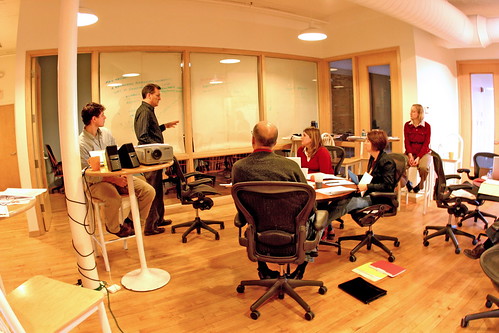
Note from Beth: Last year I was honored to partner with Kari Dunn Saratovksy from Third Plateau to facilitate an emerging leadership program to a cohort of leaders who were part of the Packard Foundation’s Science and Conservation portfolio of grantees. The project, which combined peer learning and mentoring together with an online “Emerging Leaders Playbook,” offered a new and entirely virtual approach to leadership development.
We learned a lot from this project about how best support emerging leaders and all those lessons learned have rolled into the next iteration of the Emerging Leaders Playbook — a curated collection of resources that support emerging leaders on their journey, and provides talent managers with practical tools to help retain and support emerging leaders within their organizations.
It isn’t enough to read an article about a leadership skill, it is also important to practice it as part of doing your work. The nature of today’s nonprofit workplace – fast paced and heavy workloads – makes it nearly impossible to find the reflective time to put together a learning plan and implement it. That’s why we’ve included a highly practical toolkit that consists of facilitator agendas and worksheets for nonprofits to apply the ideas and frameworks. The toolkit helps nonprofits get their work done, but also helps transform doing the work into a leadership development experience for young leaders and builds the organization’s capacity to become a learning organization.
I’ll share more about this idea in my next blog post and during a panel at CauseCamp on Tuesday, but for now here’s a post from Kari about the big picture about why investing emerging leaders development is important for nonprofits.
Emerging Leaders Need More than Leadership Development
They need organizations with a culture that can help them thrive guest post by Kari Dunn Saratovsky, Third Plateau
For decades, even centuries, our view of leadership has been defined by top-down, hierarchical structures. Today, this view is fundamentally changing. It’s being replaced by collaborative styles of leadership and the rise of programs and initiatives that are being co-created across departments and organizations.
Without making sweeping generalizations, today’s emerging social sector leaders have an increasingly egalitarian view of leadership. Rather than being tied to status, they see leaders for their ability to be collaborative, creative, display high emotional intelligence, and bring together diverse groups of people and perspectives to influence change.
While we watch the workforce fundamentally change around us, are social sector organizations primed to keep up with this changing definition of leadership?
From an emerging leader’s perspective, the kind of leadership development that supports these collaborative structures calls for a blending of both hard and soft skills. And, while technical skills are often the focus of leadership development programs — discussions about cultural competency, equity, inclusion and so much more are no longer optional — they must be embedded into organizational learning at all levels.
Inside the walls of nonprofit organizations, social sector talent managers and executive leaders must now prioritize an internal culture that embodies this new era of leadership. The traditional role of HR Directors has been to manage the “people” side of an organization — recruiting, hiring, developing, and retaining talent that would keep an organization up and running. In large part, this focuses on setting policies and creating structures to support and manage teams. While important, the changing landscape requires talent managers and HR directors move beyond the processes and policies and embed a culture of learning that can support and nurture talent within their organizations. This takes buy-in from the top down.
The most effective leadership development occurs when organizational leaders create the time and space for learning across an organization — when it truly becomes ingrained into an organization’s DNA. But what does this look like in practice, and how can talent professionals and managers more efficiently access, implement, and share quality leadership development tools and practices? While there is no shortage of resources and programs for leadership development, there remains a significant gap between the key concepts that are learned and the practical applications that can be found in the workplace.
We teamed up with Beth Kanter to explore this more deeply. We know that leaders today must understand their own strengths (leading self), recognize how they lead and manage others (leading others), and be confident in their role within an organization (influencing organizational change). That became the basis for the Emerging Leaders Playbook — a curated collection of resources that support emerging leaders on their journey, and provides talent managers with practical tools to help retain and support emerging leaders within their organizations.
Getting this right is a conversation that requires all voices at the table. We want to invite you to our virtual table. Here are a few ways you can join the conversation:
1. Visit the new Emerging Leaders Playbook for curated resources focused on Leading Self, Leading Others, and Influencing Organizational Change. And, get direct access to practical tools that you can use within your organization.
2. Check out the Emerging Leaders Collaborative Group on Facebook and begin to share resources and get tips from other emerging leaders and talent managers.
3. Join us on April 6 for a webinar with leading talent managers from Acumen, Bridgespan, and The Mission Continues and learn how to embed a culture of learning and leadership within your organization.
4. Join us on May 2 for a special session led by Beth Kanter, and take a deeper dive into the Playbook and learn how to apply the mini-modules in different settings with your team.
Leadership development today requires an investment by all of us. The challenges we face as a sector and a society are complicated. It will take a new generation of leaders armed with a different set of tools — and a new willingness on the part of organizations to create an internal culture that will support them.

Leave a Reply